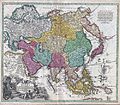Datei:1730 C. Homann Map of Asia - Geographicus - Asiae-homann-1730.jpg
Zur Navigation springen
Zur Suche springen

Größe dieser Vorschau: 687 × 600 Pixel. Weitere Auflösungen: 275 × 240 Pixel | 550 × 480 Pixel | 880 × 768 Pixel | 1.173 × 1.024 Pixel | 2.346 × 2.048 Pixel | 4.000 × 3.492 Pixel
Originaldatei (4.000 × 3.492 Pixel, Dateigröße: 5,26 MB, MIME-Typ: image/jpeg)
Dateiversionen
Klicke auf einen Zeitpunkt, um diese Version zu laden.
| Version vom | Vorschaubild | Maße | Benutzer | Kommentar | |
|---|---|---|---|---|---|
| aktuell | 18:35, 16. Mär. 2011 |  | 4.000 × 3.492 (5,26 MB) | BotMultichill | {{subst:User:Multichill/Geographicus |link=http://www.geographicus.com/P/AntiqueMap/Asiae-homann-1730 |product_name=1730 C. Homann Map of Asia |map_title=Recentissima Asiae Delineatio : Qua Imperia, eius Regna, et Status, Unacum novissimis Russorum detect |
Dateiverwendung
Die folgende Seite verwendet diese Datei:
Globale Dateiverwendung
Die nachfolgenden anderen Wikis verwenden diese Datei:
- Verwendung auf ca.wikipedia.org
- Verwendung auf el.wikipedia.org
- Verwendung auf en.wikipedia.org
- Verwendung auf es.wikipedia.org
- Verwendung auf fa.wikipedia.org
- Verwendung auf hu.wikipedia.org
- Verwendung auf hy.wikipedia.org
- Verwendung auf mk.wikipedia.org
- Verwendung auf mr.wikipedia.org
- Verwendung auf ms.wikipedia.org
- Verwendung auf pnb.wikipedia.org
- Verwendung auf pt.wikipedia.org
- Verwendung auf ru.wikipedia.org
- Verwendung auf si.wikipedia.org
- Verwendung auf sq.wikipedia.org
- Verwendung auf ta.wikipedia.org
- Verwendung auf th.wikipedia.org
- Verwendung auf ur.wikipedia.org
- Verwendung auf uz.wikipedia.org